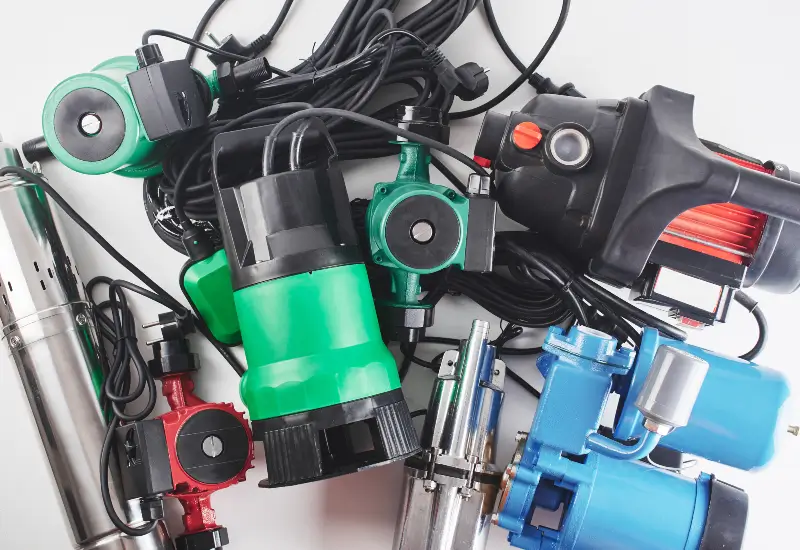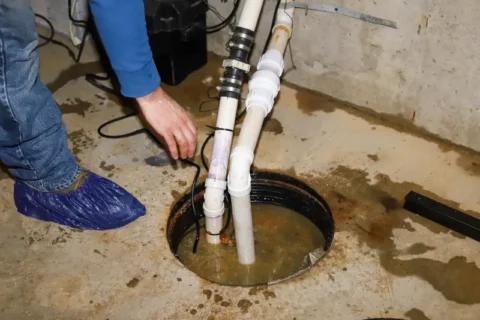Types of Sump Pumps: Which Is Right for Your Home?

Keeping your basement dry is a high priority, but how do you choose the right sump pump for your Illinois home? Explore various types of sump pumps to help you determine which one suits your needs best.
Types of Sump Pumps
Submersible Sump Pumps
As the name suggests, submersible sump pumps are designed to operate underwater. They sit directly in the sump pit, ready to power on when the water level rises.
Pros:
- Quiet operation: Being submerged means the pump operates less loudly.
- Efficient pumping: The ability to handle large volumes of water makes a submersible sump pump ideal for homes prone to heavy flooding.
- Discrete installation: The entire device is tucked away in the pit, which takes up less space in your basement.
Cons:
- Price tag: The efficiency and design of a submersible sump pump means it comes at a higher cost.
- Maintenance challenge: Since the pump is submerged, a technician must lift it out to inspect or clean it. If there’s any leftover sludge, sediment, or standing water, things can get messy.
Pedestal Sump Pumps
Pedestal sump pumps have a motor perched above the sump pit, with a hose extending down into the water.
Pros:
- Easy access: Maintenance is a breeze because the motor is dry and elevated.
- Budget-friendly: Pedestal sump pumps are lighter on the wallet.
- Longer lifespan: The average lifespan is longer than that of a submersible sump pump.
Cons:
- Noise levels: With the motor out in the open, the pump operates more loudly.
- Less powerful: Pedestal sump pumps often have a lower pumping capacity.
Battery Backup Sump Pumps
Battery backup systems come into play when the primary pump fails or a power outage occurs.
Pros:
- Reliability: A battery backup provides peace of mind by working even if the storm threatening to flood your basement knocks out the power.
- Extra muscle: If the main pump becomes overwhelmed, a battery backup can supplement its efforts to eliminate excess water.
Cons:
- Battery maintenance: Batteries need regular checks and replacements to ensure they’re ready when needed.
- Additional cost: Buying a battery backup increases the initial investment, and occasional battery replacements add to the ongoing cost.
Combination Sump Pumps
Combination sump pumps pair a traditional electric pump with a built-in battery backup.
Pros:
- All-in-one protection: You get a primary pump for everyday use and a backup for power outages.
- Space saver: Instead of installing two separate pumps, this combo keeps everything in one pit.
Cons:
- Higher upfront cost: The price reflects the fact that you’re getting two pumps in one.
- Battery maintenance required: Just like standalone battery backups, you’ll need to occasionally replace or recharge the battery.
Water-Powered Sump Pumps
Water-powered sump pumps harness the power of your home’s water supply.
Pros:
- No electricity needed: The pump operates without power, making it invaluable during outages.
- Low maintenance: With fewer moving parts, less can go wrong.
Cons:
- Water usage: The pump consumes a significant amount of potable water to remove sump water.
- Pressure dependent: Adequate municipal water pressure is required to function effectively.
Best Type of Battery for Sump Pump Backup
If you opt for a battery backup or combination sump pump, the type of battery matters:
- Lead-acid batteries are the cheapest but require regular maintenance and must be replaced more often.
- Deep-cycle batteries last longer and can be recharged multiple times.
- Absorbent glass mat (AGM) batteries are more expensive but last a long time, charge quickly, and are maintenance-free.
Sump Pump Float Switch Types
Choosing the right float switch ensures your sump pump activates at the right time and prevents unnecessary cycling. Here are the main types:
- A tethered float switch is the most common type. The switch floats with rising water, activating the pump when it reaches a certain height. It works well in deep sump pits but requires more space to operate.
- A vertical float switch moves straight up and down with the water level, making it ideal for narrow pits.
- An electronic switch uses sensors instead of a physical float. This reduces the risk of getting stuck but requires a power source, adding another potential failure point.
- A diaphragm switch senses water pressure rather than movement. It’s reliable but best for deep pits with steady water inflow.
How to Choose the Right Size Sump Pump
Bigger isn’t always better. Choosing the wrong size sump pump leads to inefficiency and increased wear and tear. Yet, an undersized unit won’t keep up with demand. Consider these factors when sizing your sump pump:
- Basement size and water volume: If you live in an area with heavy rainfall, you’ll need a pump with higher horsepower (HP).
- Standard homes: A 1/3 HP pump can handle 1,500 to 3,000 gallons per hour (GPH), sufficient for the average home.
- Larger homes or frequent flooding: A 1/2 HP pump removes 3,000 to 5,000 GPH, ideal for bigger basements and more water accumulation.
- High water table or extreme flooding: A 3/4 or 1 HP pump is necessary for severe conditions. These pumps can handle large volumes of water quickly.
How to Choose the Right Sump Pump
So, which type of sump pump is best? Consider these factors to finalize your decision:
- Flood risk: A powerful submersible pump is a smart investment if your basement is large or floods frequently. For occasional water issues, a smaller pedestal pump should suffice.
- Sump pit size: A deep, wide pit should be compatible with a submersible pump and a tethered float switch. If your pit is shallow or narrow, a pedestal pump with a vertical float switch might perform better.
- Backup needs: If power outages are common in your area, a combination, water-powered, or battery backup pump is essential.
Keep Your Basement Dry with Expert Plumbing Service
Expert Plumbing Service has over 30 years of experience helping Illinois homeowners and business owners keep their basements dry. We would be happy to help you select, size, and install a new sump pump for efficient and long-lasting performance. Contact us today for a sump pump installation service estimate in DuPage, Will, Kendall, or Kane County.
Request Your Expert Plumbing Service Today


